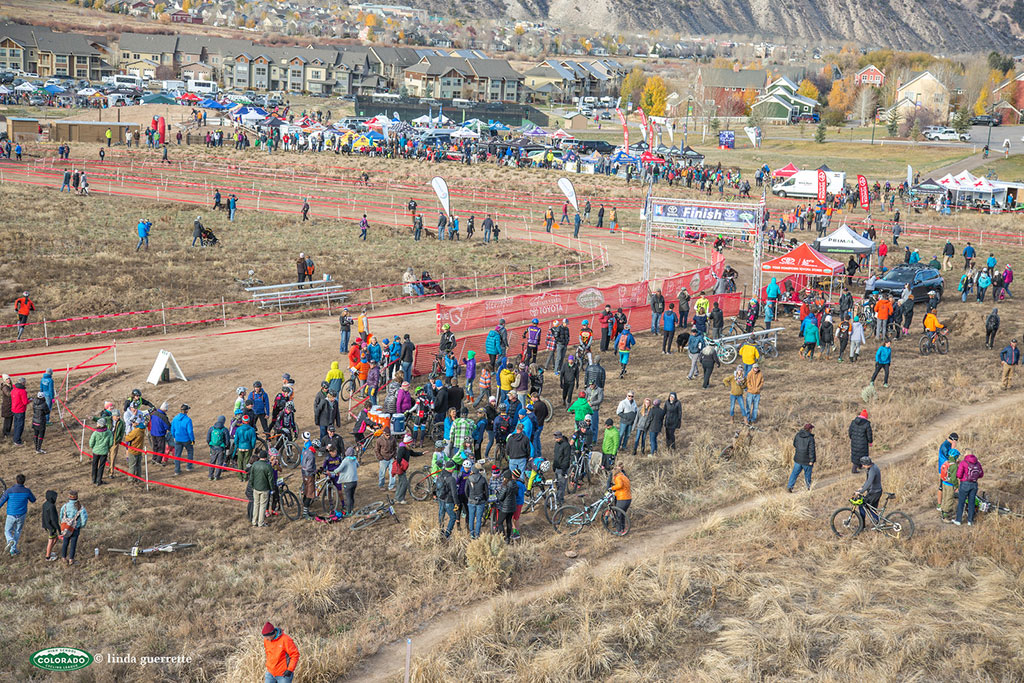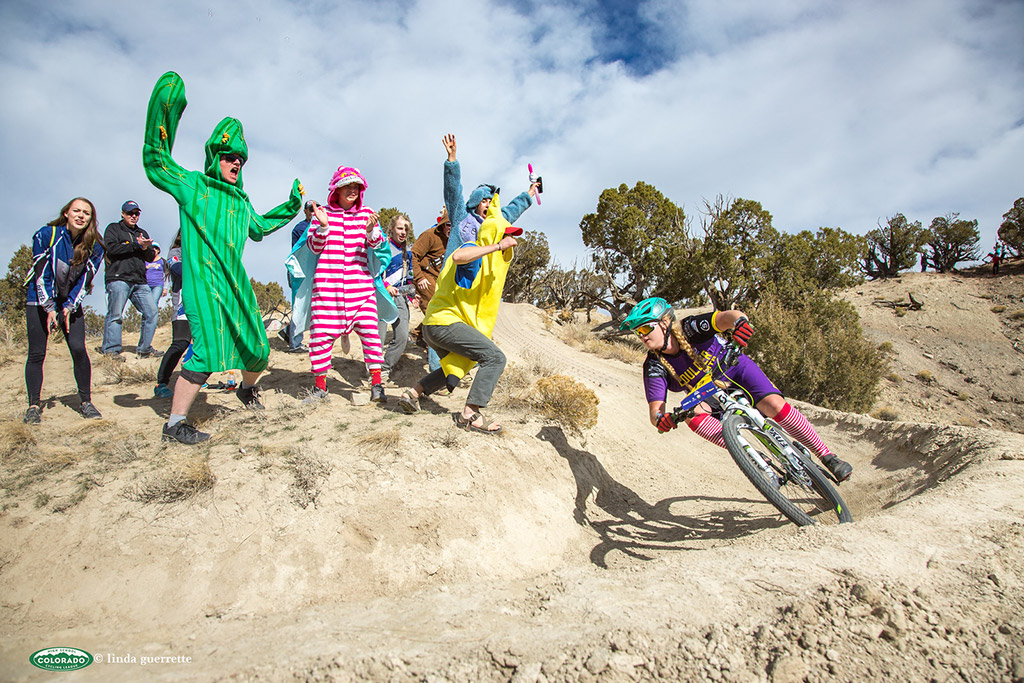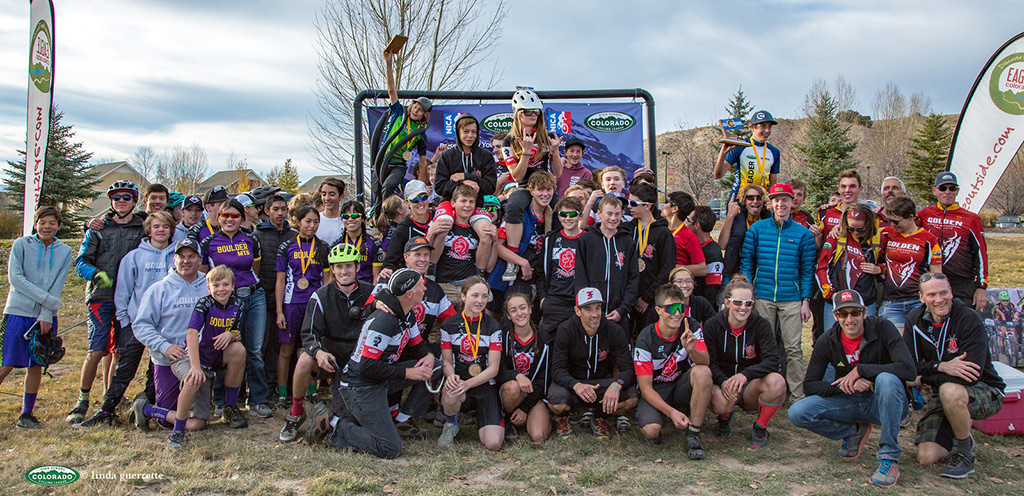In the Colorado High School Cycling League, kids discover a thousand different reasons to love riding.
When I ask my son, Hatcher, what his favorite thing about his inaugural season on the Boulder High School mountain bike team was, he says, “The rice cake.”
“The rice cake?”
“Yes, the rice cake.”
Then he describes it.
“It was wrapped in this little package. And it had bits of egg and ham in it. And it was pretty salty, which I needed when I ate it. I probably took more than my share, but once I had one, I couldn’t stop! It’s so delicious!”
Kids. You give them the world and they remember that one Draw Four in a tense Uno match in the sputtering light of a 60-watt bulb rather than how the sky, the snow, and the steeps came together in absolute perfection during their first trip to Bridger Bowl, Montana. Or in this case: You give them a whole new world of high school mountain bike racing and they remember the snacks. True it was a delicious treat, sticky and hand-formed into a square, and concocted with love from a recipe in Feed Zone Portables by those Skratch Labs guys.
I’d get to sample one (and grasp its appeal), after watching Hatcher compete in his first Colorado High School Mountain Bike League Championships, a race that took kids on a 4.9-mile trail called Haymaker, built specifically to host the championships and incorporating everything from fast, flat single and doubletrack to a lung-busting climb, rock bridges, banked berms, and slalom-style descent. Since 2014, the course has also included a 0.8-mile addition called “Extra Credit.” Miraculously, Hatcher had made the finals, out of a field of 146 northern division freshman boys who’d all ridden their hearts out in countless training rides and four previous races over the past eight weeks.

The scene at the 2017 State Championships | Photo: Linda Guerrette
Now it was a frigid morning in late October, and at this race alone, there were 622 riders in eight divisions including 204 girls. They came from schools across Colorado as well as southern Wyoming and northern New Mexico (which the Colorado League stretches into). It’s a decidedly family-centric scene. Throughout the race season, parents had gotten to pre-ride each course with their kids. Grandparents babysat younger siblings, the littlest straddling pedal-less Strider bikes. Those riders, like my six-year-old daughter, Hollis, had felt the inclusionary nature of the League when she got to help in the “feed zone,” passing water bottles to thirsty racers as they pumped past us. And just now, Hatcher’s division—freshman boys—danced around and joked, expelling nervous energy and trying to keep their muscles warm. Still, this race was a big deal, and it would not be easy.
Kate Rau, the director of the Colorado High School Cycling League, says that while there is stiff competition among the kids who want competition, “One of the best things about the League is that it’s not about the podium.”
The League promotes this by not having tryouts or cuts and by having a one-to-six coach-to-rider ratio. Hatcher’s team met for twice-a-week training rides on the trails surrounding Boulder, and did longer, more adventurous rides throughout the season. Over and over, I saw Hatcher enter the fray almost tentatively, but come home after training more jazzed on a sports practice than he’d ever been. He trained hard, too, clawing his way from 56th position in the first race, to 35th in the second, to missing the third race and finishing 39th in his fourth, to squeaking his way into the championships and actually showing some stoke while he did it. That attitude, and him sustaining it, made me beam with pride.
The National Interscholastic Cycling Association (NICA) has inspired kids like Hatch since it started, in California, in 2009. It’s now spread to 20 leagues in states across the U.S. (and several more states have non-NICA-affiliated interscholastic leagues). NICA strives to improve kids’ lives and positively impact communities by building strong bodies, minds and character in its riders. Its oversight, and an army of volunteer coaches, bike companies, parents, community members, and other kids make the phenomenon possible. And the kids come away with more than just riding and racing skills. Volunteerism is a key component. So are sportsmanship, healthy lifestyle-building, emphasis on family bonds, and friendship-building across the League. It’s incredible to think about the trickle down effect of it all when you have a program that last year supported more than 10,000 kids
So I’m more than happy to honor the fact that Hatcher’s favorite thing about his first race season was the rice cake. Because like Rau says, there are so many things to love about high school’s fastest-growing sport that the riding can almost seem secondary.
It isn’t, of course. These kids enthusiastically shred.
“Mountain bikers are so passionate about their sport that they want everyone to love it,” says Rau. “That enthusiasm makes our coaches the perfect positive role models.” The group aspect of riding encourages healthy peer relationships. And when kids come home raving about the adventure they just had on a bike, Rau says it often either re-ignites an old passion for cycling in the parent or is the nudge a parent needs to get the whole family out riding.

The crowd has as much fun as the racers. | Photo: Linda Guerrette
Any rider who wishes to race is allowed. Colorado League race weekends are celebrated with contests such as the best team chant and temporary tattoos. There’s a Slingshot award, which recognizes the female and male racer who made the biggest improvement that day from the call-up position.
Past (and present) racers have managed extra challenges, such as autism, prosthetics, chronic illnesses—cancer, diabetes—or returning to riding after a significant injury. If a racer requires an extra sweep to ensure they and others are safe and aware, race officials fully embrace that to give all riders a fair shake.
Even Hatcher’s pediatrician gushes about the benefits of bike racing: “The sun, the vitamin D, the fresh air, the release of serotonin, and the natural interval training, which happens to be great cross-training for other sports. I love it.”
What’s more, leagues focus on building diversity. Colorado’s Brett Donelson, who coaches the Battle Mountain team, does outreach to young women, and Greg Townsend, who coaches a team from a school for adjudicated youth, brought three riders to state championships this year, according to Rau. NICA facilitates league creation through its Emergent Leagues program and states like Colorado make it possible for any school to participate, with hefty scholarship programs.

The 2017 Colorado State Championship podium | Photo: Linda Guerrette
All teams are co-ed, and have both individual and team rankings. Kids earn their start position in each race based on their previous race finish. They accumulate points—leaders wear a yellow (and green) jersey, just like in the Tour de France. Teams accumulate them, too: Boulder High and another Boulder school, Fairview, duke it out perennially (Fairview’s team placed first this year, with Boulder second and Golden third). But Boulder High has always boasted the most robust team in the league, growing from 32 kids with five girls in its first year (2010) to 107 kids with 35 girls this year.
“Max was proud to represent Boulder High because of its reputation,” says Hatcher’s teammate Max Lynch’s mom, Mary Beth (who, incidentally, made the rice cakes), “and he learned a few crucial lessons in bike racing.” Don’t miss the first race (or any race for that matter) because it affects overall standing. “But Max took it in stride while learning strategy, developing new friendships, and bonding with kids through their love the outdoors, riding bikes, and bombing singletrack. Better still, he’ll carry this love of mountain biking through to adulthood.”
Nicole Silk, mother of another freshman rider (and ski racer), Ari, offered the girls’ take. “There’s an incredible amount of mutual respect and support that transcends team boundaries,” she says. “At States, Ari was trying to pass another rider in a tricky spot. Instead of being frustrated or angry, the other rider said ‘You go—good luck!’ You don’t see this kind of dynamic support in skiing, in part because skiing is singular. But in every race, the girls are looking after each other, in a way that doesn’t stifle competition. There’s a sense that they’re all in it together, and an appreciation for doing it differently than most of the guys.”
“I love how racing gives us a chance to participate in athletics as a family, not just sitting on the bleachers watching,” adds a final parent, Christine Neff, mother of freshman rider Jonas Kahila. “We all do the pre-ride, hike around to different parts of the course, and volunteer in the execution of races.” The League fosters an incredible spirit of community, she adds. “Some kids from another team noticed Jonas riding on very low tire pressure, and as they passed him, they dropped a co2 cartridge beside the trail specifically to help him out—now that’s sportsmanship.”
Traditional ball sports foster several of these qualities, too, but in no way can they touch the immersion-in-the-outdoors and love-of-wilderness elements, which are key to creating a generation who’ll go on to enjoy, respect, and protect our natural spaces.

The author and her son after the race | Photo: Linda Guerrette
In the end, Hatcher admitted to loving more about his first race season than just the rice cakes. He’d clawed his way to finals, in a tie for 50th. His ride wasn’t the best—he bonked after the first lap, and lagged—hard—in the second. But I saw the qualities the other riders and parents mentioned on display in my kid as well. He’d tell me later that, inexplicably (to him), he hit a wall, as he started his second lap. But he drew upon the fitness and good attitude reserves he’d gained over his previous two months of training and racing. And he climbed to the top of the rollercoaster descent again, with a smile on his cold-reddened face.
This is Colorado high school mountain biking.
Everyone cheered on everyone else, even if they weren’t top-of-the-pack contenders. Coaches fire-hosed their enthusiasm and parents volunteered in a dozen different capacities. Little kids rang cowbells at the sides of trails, as visions of what they might become imprinted on their brains. It’s an existence in which every rider in the high school league they enter is treated equally, all of the race venues are lovingly selected, each coach cares as much about personal development as physical development in athletes, and kids of all genders, races, economic incomes, levels of enthusiasm, and riding ability pedal together.
And even if the snacks get top billing for Hatcher, I see a groundswell of passionate mountain biking enthusiasts dedicated to raising the best possible kids by keying them into the most exciting outdoor sport I know. And that’s better than any snack you can give them.
